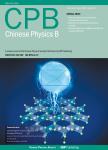Structural and electrical properties of carbon-ion-implanted ultrananocrystalline diamond films
Structural and electrical properties of carbon-ion-implanted ultrananocrystalline diamond films作者机构:College of Materials Science and Engineering Zhejiang University of Technology Hangzhou 310014 China Aston Institute of Materials Research School of Engineering and Applied Science Aston University Birmingham B4 7ET United Kingdom V. A. Kotelnikov Institute of Radio-Engineering and Electronics Russian Academy of Sciences Moscow 14l 190 Russia National Research Nuclear University MEPhI Moscow Russia
出 版 物:《Chinese Physics B》 (中国物理B(英文版))
年 卷 期:2018年第27卷第9期
页 面:426-433页
核心收录:
学科分类:08[工学] 080501[工学-材料物理与化学] 0805[工学-材料科学与工程(可授工学、理学学位)]
基 金:Project supported by the National Natural Science Foundation of China(Grant Nos.50972129 and 50602039) the International Science Technology Cooperation Program of China(Grant No.2014DFR51160) the National Key Research and Development Program of China(Grant No.2016YFE0133200) European Union’s Horizon 2020 Research and Innovation Staff Exchange(RISE)Scheme(Grant No.734578) One Belt and One Road International Cooperation Project from the Key Research and Development Program of Zhejiang Province,China(Grant No.2018C04021) Xinmiao Talents Program of Zhejiang Province,China(Grant No.2017R403078)
主 题:ultrananocrystalline diamond C-ion implantation annealing electrical properties
摘 要:We investigate the structural and electrical properties of carbon-ion-implanted ultrananocrystalline diamond(UNCD)films. Impedance spectroscopy measurements show that the impedance of diamond grains is relatively stable, while that of grain boundaries(GBs)(Rb) significantly increases after the C~+ implantation, and decreases with the increase in the annealing temperature(Ta) from 650℃ to 1000℃. This implies that the C~+ implantation has a more significant impact on the conductivity of GBs. Conductive atomic force microscopy demonstrates that the number of conductive sites increases in GB regions at Ta above 900℃, owing to the formation of a nanographitic phase confirmed by high-resolution transmission electronic microscopy. Visible-light Raman spectra show that resistive trans-polyacetylene oligomers desorb from GBs at Ta above 900℃, which leads to lower Rb of samples annealed at 900 and 1000℃. With the increase in Ta to 1000℃, diamond grains become smaller with longer GBs modified by a more ordered nanographitic phase, supplying more conductive sites and leading to a lower Rb.



